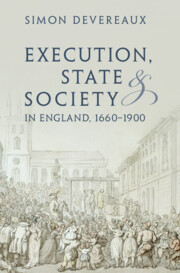Book contents
- Execution, State and Society in England, 1660–1900
- Series page
- Execution, State and Society in England, 1660–1900
- Copyright page
- Dedication
- Contents
- Figures
- Images
- Tables
- Acknowledgments
- Abbreviations
- 1 Introduction
- 2 Executions for Treason, 1660–1820
- 3 Changing Cultures of Execution: Religion and Feeling, 1660–1770
- 4 Changing Cultures of Execution: Reason and Reforms, 1770–1808
- 5 The Murder Act: Anatomization, 1752–1832
- 6 The Murder Act: Hanging in Chains, 1660–1834
- 7 The “Bloody Code” Debated, 1808–1821
- 8 The “Bloody Code” Diminished, 1822–1830
- 9 The Vicissitudes of Public Execution, 1830–1900
- 10 Conclusion
- Archival and Digital Sources
- Index
9 - The Vicissitudes of Public Execution, 1830–1900
Published online by Cambridge University Press: 12 October 2023
- Execution, State and Society in England, 1660–1900
- Series page
- Execution, State and Society in England, 1660–1900
- Copyright page
- Dedication
- Contents
- Figures
- Images
- Tables
- Acknowledgments
- Abbreviations
- 1 Introduction
- 2 Executions for Treason, 1660–1820
- 3 Changing Cultures of Execution: Religion and Feeling, 1660–1770
- 4 Changing Cultures of Execution: Reason and Reforms, 1770–1808
- 5 The Murder Act: Anatomization, 1752–1832
- 6 The Murder Act: Hanging in Chains, 1660–1834
- 7 The “Bloody Code” Debated, 1808–1821
- 8 The “Bloody Code” Diminished, 1822–1830
- 9 The Vicissitudes of Public Execution, 1830–1900
- 10 Conclusion
- Archival and Digital Sources
- Index
Summary
Although the execution crowd is a common mind’s-eye image of Victorian England, we still have much to learn or to reconsider about nineteenth-century executions. The Whig governments of the 1830s are rightly seen as far more restrained in using the gallows than their Tory predecessors, but they in fact sustained a surprisingly vigorous, residual “Bloody Code” – centred on violent crimes against property – until 1837. The prevailing conviction amongst historians that the removal of executions within prison walls in 1868 averted a move towards the complete abolition of execution is not supported by the actual character of the attempts to achieve this in parliament. The change of 1868 really did stem from concerns about the execution crowd and the complicity of urbane elites in their extent. To an under-appreciated degree, however, journalists kept the work of the gallows before the public eye through the turn of the twentieth century.
- Type
- Chapter
- Information
- Execution, State and Society in England, 1660–1900 , pp. 321 - 366Publisher: Cambridge University PressPrint publication year: 2023

